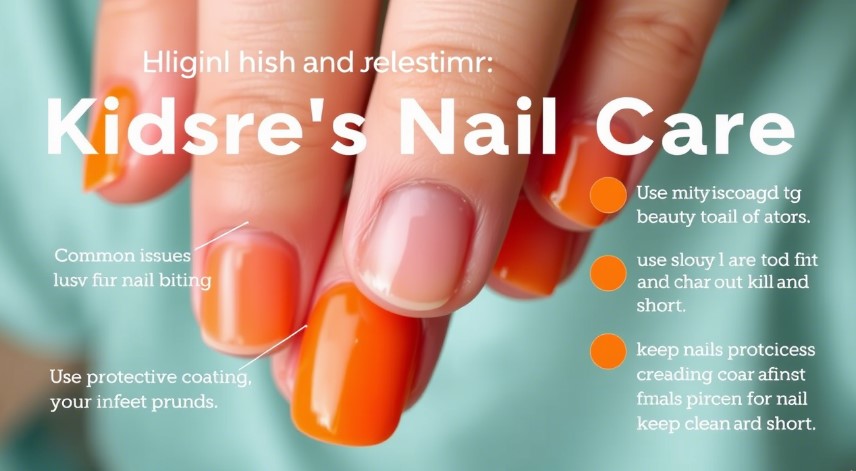Children nails may seem simple, but they need attention and care. Healthy nails protect fingertips, help with small tasks, and can show signs of overall health.

This article explains how children nails grow, common problems, and tips for keeping them strong.
Structure and Growth of Children’s Nails
Nails are made of a tough protein called keratin. They grow from the base under the skin, known as the matrix. The matrix creates new cells, pushing old ones forward to form the nail plate (the visible part). The skin around the nail is called the cuticle, which protects the matrix from germs.
Children nails grow faster than adults’ nails. Fingernails grow about 3 millimeters per month, while toenails grow slower. Growth can vary with age, diet, and health. For example, nails may grow faster in summer due to better blood flow.
Common Nail Problems in Children
Nail Biting
Many children bite their nails due to stress, boredom, or habit. This can damage the nail bed and raise the risk of infections. To help, keep nails trimmed short. Encourage stress-relief activities like drawing or using a stress ball. Praise them when they avoid biting.
Infections
- Bacterial Infections: Germs can enter through cuts or broken skin near nails. Signs include redness, swelling, or pus. Clean the area with warm water and soap. If it worsens, see a doctor.
- Fungal Infections: These cause thick, discolored nails. Fungi thrive in damp places. Avoid sharing nail tools. Use antifungal creams if needed.
Ingrown Nails
Ingrown Children nails occur when the nail edge grows into the skin, causing pain and swelling. Tight shoes or improper trimming are common causes. Cut nails straight across, not curved. Soak the foot in warm water if it happens.
White Spots
Small white spots often appear after minor injuries (like hitting a finger). They are harmless and grow out. They are not usually a sign of calcium deficiency.
Peeling or Brittle Nails
Dry weather or nutrient gaps (like low iron or vitamins) can make nails peel. Use moisturizer after washing hands. Include eggs, spinach, and nuts in their diet.
Tips for Healthy Nail Care
- Trim Regularly– Trim nails every 1–2 weeks. Use child-sized clippers or scissors. Cut fingernails slightly rounded and toenails straight. Do this after a bath when nails are softer.
- Keep Nails Clean
Dirt under nails can cause infections. Teach kids to scrub gently with a soft brush. Dry hands well to stop germs from growing. - Avoid Harsh Chemicals
Soaps or cleaners with strong chemicals can dry out nails. Use mild, moisturizing products. Wear gloves during chores. - Moisturize
Rub a small amount of petroleum jelly or hand cream on nails and cuticles. This prevents cracking. - Choose Safe Footwear
Tight shoes press nails into toes. Ensure shoes have enough space. Check fit every few months as feet grow. - Balanced Diet
Protein, biotin (in eggs), and vitamins A and C support nail health. Offer fruits, veggies, and whole grains.
When to See a Doctor
Most nail issues can be managed at home. But consult a doctor if:
- Redness, pain, or pus lasts more than 2–3 days.
- Nails turn yellow, black, or green.
- A child has frequent infections or severe ingrown nails.
- Nails become spoon-shaped, pitted, or separate from the skin.
Fun and Safe Nail Decorations
Kids love colorful nails! Use these tips for safe fun:
- Pick non-toxic, water-based nail polish. Avoid products with formaldehyde or acetone.
- Use stickers or temporary tattoos instead of polish.
- Remove polish gently with acetone-free remover. Apply moisturizer after.
- Teach older kids to avoid picking polish, which can damage nails.
Conclusion
Healthy nails are part of a child’s well-being. Regular care prevents most problems. Teach kids to wash hands, trim nails, and avoid biting. Watch for signs of infections or nutrient issues. With simple habits, children nails can stay strong and clean. Let them enjoy decorating nails safely, turning care into a fun routine!
By understanding Children nails and acting early, parents can ensure their child’s hands and feet stay happy and healthy.
FAQs
1. How often should I trim Children nails?
Trim every 1–2 weeks to prevent scratching and dirt buildup.
2. What’s the safest way to cut a baby’s nails?
Use baby nail clippers or rounded scissors, and cut straight across while they’re asleep or calm.
3. Can kids use regular nail polish?
Opt for non-toxic, water-based polishes—they’re gentler and easier to remove.
4. How do I stop nail-biting habits?
Keep nails trimmed short, distract with activities, or apply a bitter-tasting nail polish.
5. When should I see a doctor about my child’s nails?
If nails appear discolored, swollen, or have unusual ridges, consult a pediatrician.